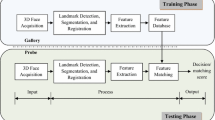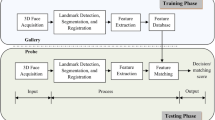Abstract
Facial image analysis is very useful in many applications such as video compression, talking heads, or biometrics. During the last few years, many algorithms have been proposed in particular for face recognition using classical 2-D images. Face is fairly easy to use and well accepted by people but generally not robust enough to be used in most practical security applications because too sensitive to variations in pose and illumination. One possibility to overcome this limitation is to work in 3-D instead of 2-D. But 3-D is costly and more difficult to manipulate and then ineffective to authenticate people in most contexts. Hence, to solve this problem, we propose a novel face recognition approach that is based on an asymmetric protocol: enrolment in 3-D but identification performed from 2-D images. So that, the goal is to make more robust face recognition while keeping the system practical. To make this 3-D/2-D approach possible, we introduce geometric invariants used in computer vision within the context of face recognition. We report preliminary experiments to evaluate robustness of invariants according to pose variations and to the accuracy of detection of facial feature points. Preliminary results obtained in terms of identification rate are encouraging.
Chapter PDF
Similar content being viewed by others
Keywords
These keywords were added by machine and not by the authors. This process is experimental and the keywords may be updated as the learning algorithm improves.
References
Blanz, V., Vetter, T.: Face Recognition Based on Fitting a 3D Morphable Model. IEEE Trans. on Pattern Analysis and Machine Intelligence 25(9), 1191–1202 (2002)
Bronstein, M., Bronstein, M.M., Kimmel, R.: Expression Invariant 3D Face Recognition. In: Kittler, J., Nixon, M.S. (eds.) AVBPA 2003. LNCS, vol. 2688, pp. 62–69. Springer, Heidelberg (2003)
Huang, J., Blanz, V., Heisele, B.: Face Recognition with Support Vector Macines and 3D Head Models. In: Lee, S.-W., Verri, A. (eds.) SVM 2002. LNCS, vol. 2388, pp. 334–341. Springer, Heidelberg (2002)
Lavagetto, F., Pockaj, R.: The Facial Animation Engine: Toward a High-Level Interface for the Design of MPEG-4 Compliant Animated Faces. IEEE Trans. on Circuits and Systems for Video Technology 2(2) (March 1999)
Weinshall, D.: Model-based invariants for 3D Vision. International Journal of Computer Vision 10(1), 27–42 (1993)
Zhu, Y., Seneviratne, L.D., Earles, S.W.E.: A New Structure of Invariant for 3D Point Sets from A single View. In: IEEE International Conference on Robotics and Automation, May 1995, pp. 1726–1731 (1995)
Geometrix, Introducing FaceVision-The New Shape of Human Identification, February 13 (2005), http://www.geometrix.com/
Author information
Authors and Affiliations
Editor information
Editors and Affiliations
Rights and permissions
Copyright information
© 2005 Springer-Verlag Berlin Heidelberg
About this paper
Cite this paper
Riccio, D., Dugelay, JL. (2005). Asymmetric 3D/2D Processing: A Novel Approach for Face Recognition. In: Roli, F., Vitulano, S. (eds) Image Analysis and Processing – ICIAP 2005. ICIAP 2005. Lecture Notes in Computer Science, vol 3617. Springer, Berlin, Heidelberg. https://doi.org/10.1007/11553595_121
Download citation
DOI: https://doi.org/10.1007/11553595_121
Publisher Name: Springer, Berlin, Heidelberg
Print ISBN: 978-3-540-28869-5
Online ISBN: 978-3-540-31866-8
eBook Packages: Computer ScienceComputer Science (R0)





